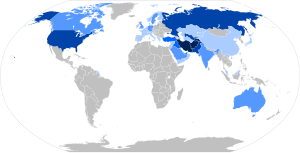نوې پارسي ( دری )
نوی پارسی ( عصري فارسي ) د فارسي ژبې اوسنۍ مرحله ده چې له اتم څخه تر نهمي پیړۍ پورې په لوی افغانستان او شاوخوا سیمو کې ویل کیږي. یاده پارسی په دودیز ډول په دریو مرحلو ویشل شوې ده :
د نوي پارسي پیل (اتم / نهمه پیړۍ)
کلاسیکه پارسي (10 پیړۍ - 18 پیړۍ)
معاصره پارسي (د 19 پیړۍ تر اوسني دورې پوري).
دري هغه نوم دی چې د لسمې پیړۍ راپه دې خوا نوي پارسي ژبي ته ورکړل سوی دی چي په پراخه کچه په عربي کي هم کارول کیږي (وګورئ استخاري ، المقدسي او ابن حوقل ) او فارسي متنونه. له ۱۹۶۴ کال راهیسې په افغانستان کې د پارسي ژبې رسمي نوم دري دی او د ایران اوسنی پارسی هم له آره د افغانستان په بلخ ولایت پوري اړه لري.
| نوې پارسی | |
|---|---|
| Lua error in Module:Lang at line 988: attempt to call field 'is_Latin' (a nil value). | |
 Fārsi written in Persian calligraphy (Nastaʿlīq) | |
| په مورنۍ ژبه |
|
شمېر ويناوال | 70 میلیونه (بدون تاریخ)[۷] (110 million total speakers)[۶] |
هندو اروپایي
| |
لومړی ډول | لرغونې پارسی
|
| Persian alphabet (Iran and Afghanistan) Tajik alphabet (Tajikistan) Hebrew alphabet Persian Braille | |
| رسمي حالت | |
رسمي ژبه په | |
| سمونوال | کينډۍ:Startplainlist
|
| د ژبې کوډونه | |
| آيسو ۶۳۹-۱ | fa |
| آيسو ۶۳۹-۲ | per (B) fas (T) |
| آيسو ۶۳۹-۳ | fas |
| ګلیټولوژیست | fars1254[۱۰] |
| ژبپوهنه | |
 Areas with significant numbers of people whose first language is Persian (including dialects) | |
 Persian Linguasphere. Legend Official language More than 1,000,000 speakers Between 500,000 – 1,000,000 speakers Between 100,000 – 500,000 speakers Between 25,000 – 100,000 speakers Fewer than 25,000 speakers / none | |
- ↑ ۱٫۰ ۱٫۱ ۱٫۲ Samadi, Habibeh; Nick Perkins (2012). Martin Ball; David Crystal; Paul Fletcher (المحررون). Assessing Grammar: The Languages of Lars. Multilingual Matters. د کتاب پاڼې 169. د کتاب نړيواله کره شمېره 978-1-84769-637-3. الوسيط
|CitationClass=تم تجاهله (مساعدة) - ↑ "IRAQ". Encyclopædia Iranica.
- ↑ "Tajiks in Turkmenistan". People Groups. الوسيط
|CitationClass=تم تجاهله (مساعدة) - ↑ Pilkington, Hilary; Yemelianova, Galina (2004). Islam in Post-Soviet Russia. Taylor & Francis. د کتاب پاڼې 27. د کتاب نړيواله کره شمېره 978-0-203-21769-6.
Among other indigenous peoples of Iranian origin were the Tats, the Talishes and the Kurds.
الوسيط|CitationClass=تم تجاهله (مساعدة) - ↑ Mastyugina, Tatiana; Perepelkin, Lev (1996). An Ethnic History of Russia: Pre-revolutionary Times to the Present. Greenwood Publishing Group. د کتاب پاڼې 80. د کتاب نړيواله کره شمېره 978-0-313-29315-3.
The Iranian Peoples (Ossetians, Tajiks, Tats, Mountain Judaists)
الوسيط|CitationClass=تم تجاهله (مساعدة) - ↑ ۶٫۰ ۶٫۱ Windfuhr, Gernot: The Iranian Languages, Routledge 2009, p. 418.
- ↑ "Persian | Department of Asian Studies" (په انګلیسي ژبه کي). د لاسرسينېټه ۰۲ جنوري ۲۰۱۹.
There are numerous reasons to study Persian: for one thing, Persian is an important language of the Middle East and Central Asia, spoken by approximately 70 million native speakers and roughly 110 million people worldwide.
الوسيط|CitationClass=تم تجاهله (مساعدة) - ↑ Constitution of the Islamic Republic of Iran: Chapter II, Article 15: "The official language and script of Iran, the lingua franca of its people, is Persian. Official documents, correspondence, and texts, as well as text-books, must be in this language and script. However, the use of regional and tribal languages in the press and mass media, as well as for teaching of their literature in schools, is allowed in addition to Persian."
- ↑ Constitution of the Republic of Dagestan: Chapter I, Article 11: "The state languages of the Republic of Dagestan are Russian and the languages of the peoples of Dagestan."
- ↑ Nordhoff, Sebastian; Hammarström, Harald; Forkel, Robert; Haspelmath, Martin, المحررون (2013). "Farsic-Caucasian Tat". Glottolog. Leipzig: Max Planck Institute for Evolutionary Anthropology. الوسيط
|CitationClass=تم تجاهله (مساعدة)صيانة CS1: عرض-المحررون (link)
